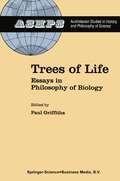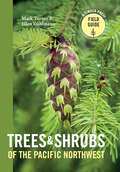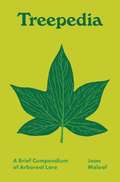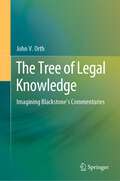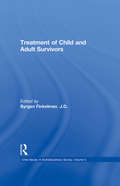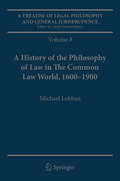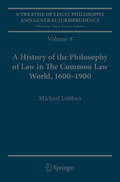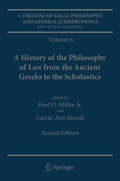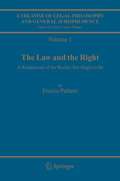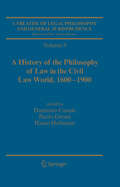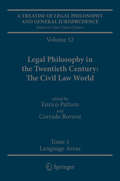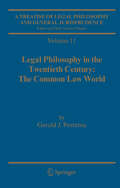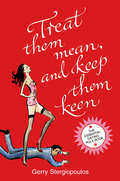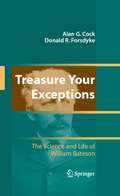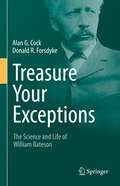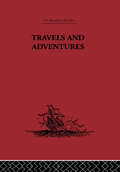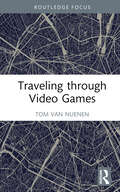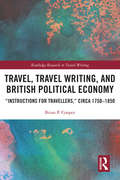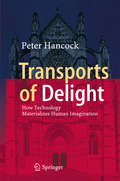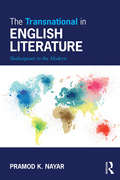- Table View
- List View
Trees of Life: Essays in Philosophy of Biology (Studies in History and Philosophy of Science #11)
by PaulGriffithsAustralia and New Zealand boast an active community of scholars working in the field of history, philosophy and social studies of science. • Australasian Studies in History and Philosophy of Science' aims to provide a distinctive publication outlet for their work. Each volume comprises a group of essays on a connected theme, edited by an Australian or a New Zealander with special expertise in that particular area .. In each volume, a majority of the contributors is from Australia or New Zealand. O;mtributions from elsewhere are by no means ruled out, however, and are indeed actively encouraged wherever appropriate to the balance of the volume in question. Earlier volumes in the series have been welcomed for significantly advancing the discussion of the topics they have dealt with. The present volume will I believe be greeted equally enthusiastically by readers in many parts of the world. R. W. Home General Editor Australasian Studies in History and Philosophy of Science TABLE OF CONTENTS v FOREWORD PAUL GRIFFITHS / Introduction 1 SECTION ONE: BEYOND NATURAL SELECTION ELLIOTI SOBER / Models of Cultural Evolution 17 KIM STERELNY / Punctuated Equilibrium and Macroevolution 41 ROBIN CRAW / Margins of Cladistics: Identity, Difference and Place in the Emergence of Phylogenetic Systematics 1864-1975 65 SECTION TWO: CENTRAL CONCEPTS OF EVOLUTIONARY THEORY PAUL GRIFFITHS / Adaptive Explanation and the Concept of a Vestige 111 TIMOTHY SHANAHAN / Selection, Drift and the Aims of Evolutionary Theory 133 SECTION THREE: THE DEVELOPMENTAL SYSTEMS APPROACH
Trees and Shrubs of the Pacific Northwest (A Timber Press Field Guide)
by Mark Turner Ellen KuhlmannAs a part of the Timber Press Field Guide book series, Trees and Shrubs of the Pacific Northwest is the must-have book for accurate identification of regional flora.
Treepedia: A Brief Compendium of Arboreal Lore (Pedia Books)
by Joan MaloofA captivating A–Z treasury for the tree hugger in all of usTreepedia is an entertaining and fact-filled illustrated compendium of tree lore. Featuring nearly 100 entries—on topics ranging from tree ecology and conservation to the role of trees in religion, literature, art, and movies—this enticing collection is a celebration of all things arboreal.In this charming book, Joan Maloof explains the difference between a cedar and a cypress, and reveals where to find the most remarkable trees on the planet. She tells the story behind the venerable Bodhi Tree, and describes peculiar species like baobabs and Fitzroya. Maloof profiles legendary conservationists such as Julia "Butterfly" Hill, John Muir, Wangari Maathai, and Ken Wu. She discusses reforestation, proforestation, emerald ash borers, the ents from The Lord of the Rings, culturally modified trees, the ill-fated and controversial Redwood Summer, and much more. The book's portable size makes it the perfect travel companion no matter where your love of the forest may lead you.With enchanting illustrations by Maren Westfall, Treepedia is a fun and informative book that is guaranteed to inspire anyone who has ever enjoyed a walk in the woods.Features a real cloth cover with an elaborate foil-stamped designUses 100 percent recycled, uncoated, wood-free paper
Treepedia: A Brief Compendium of Arboreal Lore (Pedia Books)
by Joan MaloofA captivating A–Z treasury for the tree hugger in all of usTreepedia is an entertaining and fact-filled illustrated compendium of tree lore. Featuring nearly 100 entries—on topics ranging from tree ecology and conservation to the role of trees in religion, literature, art, and movies—this enticing collection is a celebration of all things arboreal.In this charming book, Joan Maloof explains the difference between a cedar and a cypress, and reveals where to find the most remarkable trees on the planet. She tells the story behind the venerable Bodhi Tree, and describes peculiar species like baobabs and Fitzroya. Maloof profiles legendary conservationists such as Julia "Butterfly" Hill, John Muir, Wangari Maathai, and Ken Wu. She discusses reforestation, proforestation, emerald ash borers, the ents from The Lord of the Rings, culturally modified trees, the ill-fated and controversial Redwood Summer, and much more. The book's portable size makes it the perfect travel companion no matter where your love of the forest may lead you.With enchanting illustrations by Maren Westfall, Treepedia is a fun and informative book that is guaranteed to inspire anyone who has ever enjoyed a walk in the woods.Features a real cloth cover with an elaborate foil-stamped designUses 100 percent recycled, uncoated, wood-free paper
The Tree of Legal Knowledge: Imagining Blackstone’s Commentaries
by John V. OrthThis book restores to view a masterpiece of beauty and legal scholarship, which has been lost for almost two hundred years. Produced anonymously in 1838, The Tree of Legal Knowledge is an elaborate visualization in five large colored plates of the law as stated in Sir William Blackstone’s Commentaries on the Laws of England. Intended as “an assistant for students in the study of law,” the study aid was not a simple diagram but a beautiful tree with each branch and twig labeled with legal terms and concepts from the Commentaries. Not for law students only, the original was also intended to be of use to the practicing attorney and educated gentleman “in consolidating his learning and forming an instructive and ornamental appendage to an office.” Although Blackstone’s Commentaries had been first published eighty years earlier, it remained the primary source for knowledge of English law and required reading for American law students. The Commentaries remain relevant today and are frequently cited by the U.S. Supreme Court as a source for the original understanding of legal rights and obligations at the time of American Independence. Despite its artistic beauty and academic significance, The Tree of Legal Knowledge had seemingly disappeared shortly after its publication. It is not included in the collection of any library, including the Library of Congress or in Yale University’s Blackstone Collection, the largest in the world. It is not listed in the comprehensive Bibliographical Catalog of William Blackstone, edited by Ann Jordan Laeuchli, published for the Yale Law Library in 2015. The present volume reproduces the only extant copy of The Tree of Legal Knowledge. It includes an introduction by the editor that places The Tree in historical context and identifies the anonymous author, an otherwise unknown lawyer. In addition, it reprints the original author’s introduction and “explanation of the branches,” both extensively annotated. This book restores this lost masterpiece to its proper place in legal history. The Tree is a beautiful—and accurate—depiction of English law as expounded in Blackstone’s Commentaries, the single most important book in the history of the common law.
Treatment of Child and Adult Survivors (Child Abuse: A Multidisciplinary Survey #5)
by Byrgen Finkelman J. D.First published in 1995. Routledge is an imprint of Taylor & Francis, an informa company.
Treatment of Child and Adult Survivors (Child Abuse: A Multidisciplinary Survey)
by Byrgen P. FinkelmanFirst published in 1995. Routledge is an imprint of Taylor & Francis, an informa company.
A Treatise of Legal Philosophy and General Jurisprudence: Volume 7: The Jurists’ Philosophy of Law from Rome to the Seventeenth Century, Volume 8: A History of the Philosophy of Law in The Common Law World, 1600–1900
by Michael LobbanThe first-ever multivolume treatment of the issues in legal philosophy and general jurisprudence, from both a theoretical and a historical perspective. The work is aimed at jurists as well as legal and practical philosophers. Edited by the renowned theorist Enrico Pattaro and his team, this book is a classical reference work that would be of great interest to legal and practical philosophers as well as to jurists and legal scholar at all levels. The work is divided The theoretical part (published in 2005), consisting of five volumes, covers the main topics of the contemporary debate; the historical part, consisting of six volumes (Volumes 6-8 published in 2007; Volumes 9 and 10, published in 2009; Volume 11 published in 2011 and volume 12 forthcoming in 2015), accounts for the development of legal thought from ancient Greek times through the twentieth century. The entire set will be completed with an index.Volume 7: The Jurists’ Philosophy of Law from Rome to the Seventeenth Centuryedited by Andrea Padovani and Peter SteinVolume 7 is the second of the historical volumes and acts as a complement to the previous Volume 6, discussing from the jurists’ perspective what that previous volume discusses from the philosophers’ perspective. The subjects of analysis are, first, the Roman jurists’ conception of law, second, the metaphysical and logical presuppositions of late medieval legal science, and, lastly, the connection between legal and political thought up to the 17th century. The discussion shows how legal science proceeds at every step of the way, from Rome to early modern times, as an enterprise that cannot be untangled from other forms of thought, thus giving rise to an interest in logic, medieval theology, philosophy, and politics—all areas where legal science has had an influence. Volume 8: A History of the Philosophy of Law in The Common Law World, 1600–1900 by Michael LobbanVolume 8, the third of the historical volumes, offers a history of legal philosophy in common-law countries from the 17th to the 19th century. Its main focus (like that of Volume 9) is on the ways in which jurists and legal philosophers thought about law and legal reasoning. The volume begins with a discussion of the ‘common law mind’ as it evolved in late medieval and early modern England. It goes on to examine the different jurisprudential traditions which developed in England and the United States, showing that while Coke’s vision of the common law continued to exert a strong influence on American jurists, in England a more positivist approach took root, which found its fullest articulation in the work of Bentham and Austin.
A Treatise of Legal Philosophy and General Jurisprudence: Volume 8: A History of the Philosophy of Law in The Common Law World, 1600–1900
by Michael LobbanVolume 8, the third of the historical volumes of A Treatise of Legal Philosophy and General Jurisprudence, offers a history of legal philosophy in common-law countries from the 17th to the 19th century. Its main focus (like that of Volume 9) is on the ways in which jurists and legal philosophers thought about law and legal reasoning. The volume begins with a discussion of the ‘common law mind’ as it evolved in late medieval and early modern England. It goes on to examine the different jurisprudential traditions which developed in England and the United States, showing that while Coke’s vision of the common law continued to exert a strong influence on American jurists, in England a more positivist approach took root, which found its fullest articulation in the work of Bentham and Austin.
A Treatise of Legal Philosophy and General Jurisprudence: Volume 6: A History of the Philosophy of Law from the Ancient Greeks to the Scholastics
by Fred D. Miller Carrie-Ann BiondiThe first-ever multivolume treatment of the issues in legal philosophy and general jurisprudence, from both a theoretical and a historical perspective. The work is aimed at jurists as well as legal and practical philosophers. Edited by the renowned theorist Enrico Pattaro and his team, this book is a classical reference work that would be of great interest to legal and practical philosophers as well as to jurists and legal scholar at all levels. The work is divided in two parts. The theoretical part (published in 2005), consisting of five volumes, covers the main topics of the contemporary debate; the historical part, consisting of six volumes (Volumes 6-8 published in 2007; Volumes 9 and 10, published in 2009; Volume 11 published in 2011 and Volume 12 forthcoming in 2015), accounts for the development of legal thought from ancient Greek times through the twentieth century. The entire set will be completed with an index.Volume 6: A History of the Philosophy of Law from the Ancient Greeks to the Scholastics 2nd revised edition, edited by Fred D. Miller, Jr. and Carrie-Ann Biondi Volume 6 is the first of the Treatise’s historical volumes (following the five theoretical ones) and is dedicated to the philosophers’ philosophy of law from ancient Greece to the 16th century. The volume thus begins with the dawning of legal philosophy in Greek and Roman philosophical thought and then covers the birth and development of European medieval legal philosophy, the influence of Judaism and the Islamic philosophers, the revival of Roman and Christian canon law, and the rise of scholastic philosophy in the late Middle Ages, which paved the way for early-modern Western legal philosophy. This second, revised edition comes with an entirely new chapter devoted to the later Scholastics (Chapter 14, by Annabel Brett) and an epilogue (by Carrie-Ann Biondi) on the legacy of ancient and medieval thought for modern legal philosophy, as well as with updated references and indexes.
A Treatise of Legal Philosophy and General Jurisprudence: Volume 1:The Law and The Right, Volume 2: Foundations of Law, Volume 3: Legal Institutions and the Sources of Law, Volume 4: Scienta Juris, Legal Doctrine as Knowledge of Law and as a Source of Law, Volume 5: Legal Reasoning, A Cognitive Approach to the Law
by Enrico PattaroThis paperback edition of the first of the twelve volumes of A Treatises of Legal Philosophy and General Jurisprudence, serves as an introduction to the first-ever multivolume treatment of all important issues in legal philosophy and general jurisprudence, consisting of a five-volume theoretical part and a six-volume historical part. The theoretical part covers the main topics of contemporary debate. The historical volumes trace the development of legal thought from ancient Greek times through the twentieth century. All volumes are edited by the renowned theorist Enrico Pattaro.
A Treatise of Legal Philosophy and General Jurisprudence: Vol. 9: A History of the Philosophy of Law in the Civil Law World, 1600-1900; Vol. 10: The Philosophers' Philosophy of Law from the Seventeenth Century to Our Days.
by Enrico PattaroTO VOLUMES 9 AND 10 OF THE TREATISE I am happy to present here the third batch of volumes for the Treatise project: This is the batch consisting of Volumes 9 and 10, namely, A History of the P- losophy of Law in the Civil Law World, 1600–1900, edited by Damiano Canale, Paolo Grossi, and Hasso Hofmann, and The Philosophers’ Philosophy of Law from the Seventeenth Century to Our Days, by Patrick Riley. Three v- umes will follow: Two are devoted to the philosophy of law in the 20th c- tury, and the third one will be the index for the entire Treatise, which will 1 therefore ultimately comprise thirteen volumes. This Volume 9 runs parallel to Volume 8, A History of the Philosophy of Law in the Common Law World, 1600–1900, by Michael Lobban, published in 2007. Volume 10, for its part, takes up where Volume 6 left off: which appeared under the title A History of the Philosophy of Law from the Ancient Greeks to the Scholastics (edited by Fred Miller Jr. in association with Carrie-Ann Biondi, likewise published in 2007), and which is mainly a history of the p- losophers’ philosophy of law (let us refer to this philosophy as A).
A Treatise of Legal Philosophy and General Jurisprudence: Volume 12 Legal Philosophy in the Twentieth Century: The Civil Law World, Tome 1: Language Areas, Tome 2: Main Orientations and Topics
by Enrico Pattaro Corrado RoversiA Treatise of Legal Philosophy and General Jurisprudence is the first-ever multivolume treatment of the issues in legal philosophy and general jurisprudence, from both a theoretical and a historical perspective. The work is aimed at jurists as well as legal and practical philosophers. Edited by the renowned theorist Enrico Pattaro and his team, this book is a classical reference work that would be of great interest to legal and practical philosophers as well as to jurists and legal scholar at all levels. The work is divided in two parts. The theoretical part (published in 2005), consisting of five volumes, covers the main topics of the contemporary debate; the historical part, consisting of six volumes (Volumes 6-8 published in 2007; Volumes 9 and 10, published in 2009; Volume 11 published in 2011 and Volume 12 forthcoming in 2016), accounts for the development of legal thought from ancient Greek times through the twentieth century. Volume 12 Legal Philosophy in the Twentieth Century: The Civil Law WorldVolume 12 of A Treatise of Legal Philosophy and General Jurisprudence, titled Legal Philosophy in the Twentieth Century: The Civil-Law World, functions as a complement to Gerald Postema’s volume 11 (titled Legal Philosophy in the Twentieth Century: The Common Law World), and it offers the first comprehensive account of the complex development that legal philosophy has undergone in continental Europe and Latin America since 1900. In this volume, leading international scholars from the different language areas making up the civil-law world give an account of the way legal philosophy has evolved in these areas in the 20th century, the outcome being an overall mosaic of civil-law legal philosophy in this arc of time. Further, specialists in the field describe the development that legal philosophy has undergone in the 20th century by focusing on three of its main subjects—namely, legal positivism, natural-law theory, and the theory of legal reasoning—and discussing the different conceptions that have been put forward under these labels. The layout of the volume is meant to frame historical analysis with a view to the contemporary theoretical debate, thus completing the Treatise in keeping with its overall methodological aim, namely, that of combining history and theory as a necessary means by which to provide a comprehensive account of jurisprudential thinking.
A Treatise of Legal Philosophy and General Jurisprudence: Volume 11: Legal Philosophy in the Twentieth Century: The Common Law World
by Gerald J. PostemaVolume 11, the sixth of the historical volumes of A Treatise of Legal Philosophy and General Jurisprudence, offers a fresh, philosophically engaged, critical interpretation of the main currents of jurisprudential thought in the English-speaking world of the 20th century. It tells the tale of two lectures and their legacies: Oliver Wendell Holmes, Jr.’s “The Path of Law” (1897) and H.L.A. Hart’s Holmes Lecture, “Positivism and the Separation of Law and Morals” (1958). Holmes’s radical challenge to late 19th century legal science gave birth to a rich variety of competing approaches to understanding law and legal reasoning from realism to economic jurisprudence to legal pragmatism, from recovery of key elements of common law jurisprudence and rule of law doctrine in the work of Llewellyn, Fuller and Hayek to root-and-branch attacks on the ideology of law by the Critical Legal Studies and Feminist movements. Hart, simultaneously building upon and transforming the undations of Austinian analytic jurisprudence laid in the early 20th century, introduced rigorous philosophical method to English-speaking jurisprudence and offered a reinterpretation of legal positivism which set the agenda for analytic legal philosophy to the end of the century and beyond. A wide-ranging debate over the role of moral principles in legal reasoning, sparked by Dworkin’s fundamental challenge to Hart’s theory, generated competing interpretations of and fundamental challenges to core doctrines of Hart’s positivism, including the nature and role of conventions at the foundations of law and the methodology of philosophical jurisprudence.
Treat them Mean and Keep them Keen: The Essential Dating Rule Book
by Gerry Stergiopoulos'I look at the way some women behave when they're dating, and I'm sorry girls, but it's an absolute car crash. The rules of successful dating are simple, but I bet you've been breaking them all.'After seeing too many of his female friends left all dressed up with nowhere to go, Gerry Stergiopoulos, every woman's ultimate best gay friend, has gone on a quest to understand why so many fabulous women have a catastrophic love life.Gerry unflinchingly enters a world of waxing, Spanx pants, dodgy self-help books, internet dating, wingwomen and smirting, to bring you his tried-and-tested History Channel technique, his perfect killer one-liners, the ingenious blackjack-based Scottish Shower system, the unbreakable three-month rule and even some sound lessons from his native Greece. Treat Them Mean and Keep Them Keen is the only dating book that gives it to you straight: it tells you what to hide and just how much to reveal, what to do and when to do it. You might be shocked at what Gerry suggests - but his advice works.
Treasure Your Exceptions: The Science and Life of William Bateson
by Alan Cock Donald R. ForsdykeThis biography provides an understanding of William Bateson as well as a reconciliation of diverging views (e.g. the hierarchical thinking of Gould and the genocentrism of George Williams and Richard Dawkins). Evolutionists may thus, at long last, present a unified front to their creationist opponents. The pressing need for this text is apparent from the high percentages reported not to believe in evolution and the growth of the so-called "intelligent design" movement.
Treasure Your Exceptions: The Science and Life of William Bateson
by Alan G. Cock Donald R. ForsdykeThis biography provides an understanding of William Bateson as well as a reconciliation of diverging views (e.g. the hierarchical thinking of Gould and the genocentrism of George Williams and Richard Dawkins). Evolutionists may thus, at long last, present a unified front to their creationist opponents. The pressing need for this text is apparent from the high percentages reported not to believe in evolution and the growth of the so-called "intelligent design" movement.
Travels and Adventures: 1435-1439
by Pero Tafur'A document of unique interest it is a picture of Europe at a most critical moment of its history, when the Continent was overwhelmed by misery, disease and unrest. A cool observer, without prejudice or excitement Tafur noted the symptoms of decay.' Sunday Times.This edition, translated and edited by Malcolm Letts, was the first complete translation of Tafur in any language.
Travels and Adventures: 1435-1439
by Pero Tafur'A document of unique interest it is a picture of Europe at a most critical moment of its history, when the Continent was overwhelmed by misery, disease and unrest. A cool observer, without prejudice or excitement Tafur noted the symptoms of decay.' Sunday Times.This edition, translated and edited by Malcolm Letts, was the first complete translation of Tafur in any language.
Traveling through Video Games (Routledge Advances in Game Studies)
by Tom van NuenenThis book unlocks an understanding of video games as virtual travel. It explains how video game design increasingly takes cues from the promotional language of tourism, and how this connection raises issues of power and commodification. Bridging the disciplinary gap between game and tourism studies, the book offers a comprehensive account of touristic gazing in games such as The Legend of Zelda: Breath of the Wild, Minecraft, and Microsoft Flight Simulator 2020. Traveling through video games involves a mythological promise of open-ended opportunity, summarized in the slogan you can go there. Van Nuenen discusses the scale of game worlds, the elusive nature of freedom and control, and the pivotal role of work in creating a sense of belonging. The logic of tourism is fundamentally consumptive—but through design choices, players can also be invited to approach their travels more critically. This is the difference between moving through a game world, and being moved by it. This interdisciplinary and innovative study will interest students and scholars of digital media studies, game studies, tourism and technology, and the Digital Humanities.
Traveling through Video Games (Routledge Advances in Game Studies)
by Tom van NuenenThis book unlocks an understanding of video games as virtual travel. It explains how video game design increasingly takes cues from the promotional language of tourism, and how this connection raises issues of power and commodification. Bridging the disciplinary gap between game and tourism studies, the book offers a comprehensive account of touristic gazing in games such as The Legend of Zelda: Breath of the Wild, Minecraft, and Microsoft Flight Simulator 2020. Traveling through video games involves a mythological promise of open-ended opportunity, summarized in the slogan you can go there. Van Nuenen discusses the scale of game worlds, the elusive nature of freedom and control, and the pivotal role of work in creating a sense of belonging. The logic of tourism is fundamentally consumptive—but through design choices, players can also be invited to approach their travels more critically. This is the difference between moving through a game world, and being moved by it. This interdisciplinary and innovative study will interest students and scholars of digital media studies, game studies, tourism and technology, and the Digital Humanities.
Travel, Travel Writing, and British Political Economy: “Instructions for Travellers,” circa 1750–1850 (Routledge Research in Travel Writing)
by Brian P. CooperThe book draws on the history of economics, literary theory, and the history of science to explore how European travelers like Alexander von Humboldt and their readers, circa 1750–1850, adapted the work of British political economists, such as Adam Smith, to help organize their observations, and, in turn, how political economists used travelers’ observations in their own analyses. Cooper examines journals, letters, books, art, and critical reviews to cast in sharp relief questions raised about political economy by contemporaries over the status of facts and evidence, whether its principles admitted of universal application, and the determination of wealth, value, and happiness in different societies. Travelers citing T.R. Malthus’s population principle blurred the gendered boundaries between domestic economy and British political economy, as embodied in the idealized subjects: domestic woman and economic man. The book opens new realms in the histories of science in its analyses of debates about gender in social scientific observation: Maria Edgeworth, Maria Graham, and Harriet Martineau both observe a role associated with women and methodically interpret what they observe, an act reserved, in theory, by men.
Travel, Travel Writing, and British Political Economy: “Instructions for Travellers,” circa 1750–1850 (Routledge Research in Travel Writing)
by Brian P. CooperThe book draws on the history of economics, literary theory, and the history of science to explore how European travelers like Alexander von Humboldt and their readers, circa 1750–1850, adapted the work of British political economists, such as Adam Smith, to help organize their observations, and, in turn, how political economists used travelers’ observations in their own analyses. Cooper examines journals, letters, books, art, and critical reviews to cast in sharp relief questions raised about political economy by contemporaries over the status of facts and evidence, whether its principles admitted of universal application, and the determination of wealth, value, and happiness in different societies. Travelers citing T.R. Malthus’s population principle blurred the gendered boundaries between domestic economy and British political economy, as embodied in the idealized subjects: domestic woman and economic man. The book opens new realms in the histories of science in its analyses of debates about gender in social scientific observation: Maria Edgeworth, Maria Graham, and Harriet Martineau both observe a role associated with women and methodically interpret what they observe, an act reserved, in theory, by men.
Transports of Delight: How Technology Materializes Human Imagination
by Peter HancockThis inspiring book shows how the spiritual side of life, with its thoughts, feelings, and aspirations, is intimately bound up with our material technologies. From the wonder of Gothic Cathedrals, to the quiet majesty of lighter than air flight, to the ultimate in luxury of the north Atlantic steamers, Peter Hancock explores how these sequential heights of technology have enabled our dreams of being transported to new and uncharted realms to become reality. Sometimes literally, sometimes figuratively, technology has always been there to make material the visions of our imagination. This book shows how this has essentially been true for all technologies from Stonehenge to space station.But technology is far from perfect. Indeed, the author argues here that some of the most public and tragic of its failures still remain instructive, emblematic, and even inspiring. He reports on examples such as a Cathedral of the Earth (Beauvais), a Cathedral of the Seas (Titanic), and a Cathedral of the Air (Hindenburg) and tells their stories from the viewpoint of material transcendence. By interweaving their stories he reveals how technologies can succeed in elevating human beings and, in taking them to whole new realms of being, he explores and explains why these experiences are ‘Transports of Delight.’
The Transnational in English Literature: Shakespeare to the Modern
by Pramod K. NayarThe Transnational in English Literature examines English literary history through its transnational engagements and argues that every period of English Literature can be examined through its global relations. English identity and nationhood is therefore defined through its negotiation with other regions and cultures. The first book to look at the entirety of English literature through a transnational lens, Pramod Nayar: Maps the discourses that constitute the global in every age, from the Early Modern to the twentieth century Offers readings of representative texts in poetry, fiction, essay and drama, covering a variety of genres such as Early Modern tragedy, the adventure novel, the narrative poem, Gothic and utopian fiction Examines major authors including Shakespeare, Defoe, Behn, Swift, Coleridge, Wordsworth, Austen, Mary Shelley, the Brontës, Doyle, Ballantyne, Orwell, Conrad, Kipling, Forster Looks at themes such as travel and discovery, exoticism, mercantilism, commodities, the civilisational mission and the multiculturalization of England. Useful for students and academics alike this book offers a comprehensive survey of the English canon questioning and analysing the transnational and global engagements of English literature.
